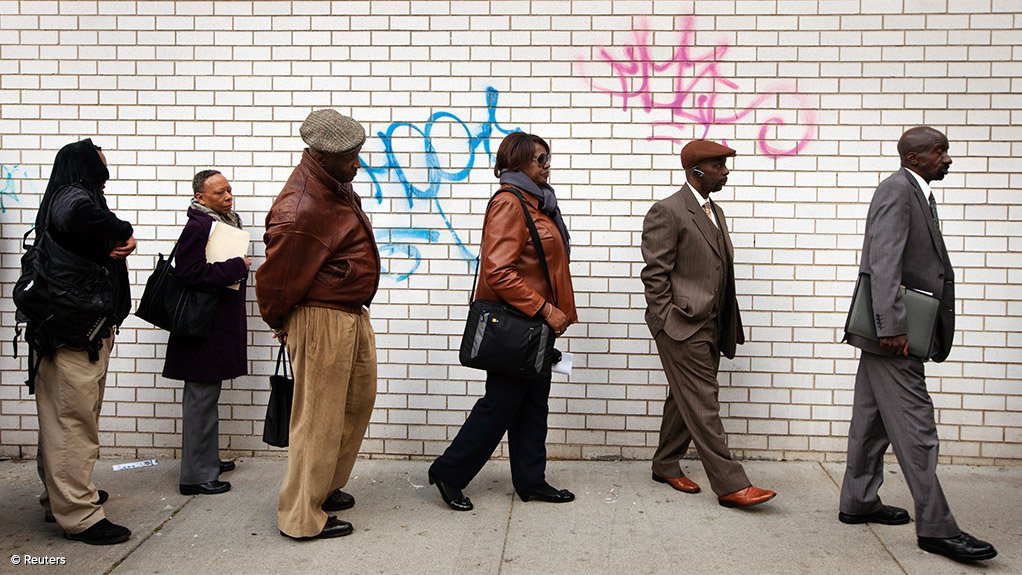The number of people employed in the formal, nonagricultural sector of the South African economy increased by about 155 000 people, or 1.8%, from March to an estimated 8.67-million employees in June, Statistics South Africa’s (Stats SA’s) latest Quarterly Employment Statistics (QES) survey has revealed.
The quarter-on-quarter increase in employment was mainly driven by the community services industry, which added 143 000 jobs during the three-months ended June, amounting to a 5.8% increase.
BNP Paribas economist Jeffrey Schultz said the second-quarter QES growth was above expectations following only 13 000 jobs having been created during the first quarter.
During the second quarter, employment in the trade industry also increased by 1%, or 17 000 people, while the construction and finance industries showed increases of 1.2% and 0.1% respectively.
However, employment in the manufacturing sector declined by 6 000 people, or 0.5% quarter-on-quarter, while the mining industry showed a 0.2% decline and the electricity sector lost 1 000 jobs, or 1.6%.
Year-on-year, the total number of formal, nonagricultural employees increased by 229 000 employees, or 2.7%, in June.
“The bulk of the improvement in formal, nonagricultural employment in the second quarter continues to be driven through the public sector with little evidence of labour-market traction in the productive private sector,” Schultz said, adding that the “disappointing” employment growth was underpinned by a weak domestic economy coupled with wage settlements which had generally been well above the prevailing levels of inflation.
He explained that as the public sector had accounted for around 70% of the 580 000 jobs created in the formal sector since 2010, this pointed to a government which seemed determined to prop up what would otherwise be a dire labour-market environment.
“We are concerned, however, at [government’s] doggedness to achieve this, [despite the] the ever-growing pressure on the fiscus. This is something that both ourselves and the rating agencies will be watching closely for any evidence of slippage in the October 22 medium-term budget,” Schultz commented.
Further, the QES also showed that gross earnings by employees in the formal nonagricultural sector increased by 1%, or R3.99-billion, to R408.88-billion during the June quarter.
Meanwhile, Stats SA statistician-general Pali Lehohla on Monday said Stats SA would be undertaking a review of the QES sample frame to address discrepancies between the data produced by the QES and that generated through the Stats SA Quarterly Labour Force Survey (QLFS).
He noted that while there were some differences between the data collected by the two surveys, such as that the QLFS included the agriculture sector and data from private household employment, even once the QLFS had been adjusted for these factors there was still a discrepancy of about one-million people between the two surveys.
Lehohla noted that this was as a result of the sample frame of the QES being unstable, explaining that the data for the QES was collected from business registers.
While these business registers, kept by the South African Revenue Service and the Companies and Intellectual Property Commission, had improved over time, more work still had to be done, he added.
Over the course of the next two years, Stats SA would improve the sample frame for the QES by firstly assessing taxpayers’ IRP5 data and integrating this into the business register.
This was expected to take place by May 2015, following which an employment framework would be created by October 2015.
Stats SA would then draw a new sample by January 2016, clean the sample by March 2016 and start collecting data from this new sample by June 2016.
Therefore, Stats SA expected QES reporting using the new sample to start in September 2016.
Lehohla stated that while this process was ongoing, the QES would still be released on a quarterly basis.
EMAIL THIS ARTICLE SAVE THIS ARTICLE
To subscribe email subscriptions@creamermedia.co.za or click here
To advertise email advertising@creamermedia.co.za or click here











